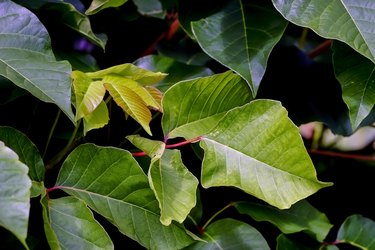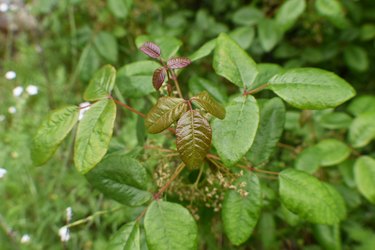
Poison sumac (Toxicodendron vernix) is a toxic shrub that thrives in the central eastern and East Coast of North America, in U.S. Department of Agriculture plant hardiness zones 3 through 8. The best chemical to kill sumac is glyphosate, but if you prefer a homemade weed killer, a vinegar solution and persistence can control smaller poison sumac plants.
Types of Poison Vines
Video of the Day
Previously known as Rhus vernix, poison sumac is one of the terrible trio of toxic shrubs or vines in North America. Along with poison ivy (Toxicodendron radicans) and poison oak (Toxicodendron pubescens and Toxicodendron diversilobum), hardy in USDA zones 4 through 10 and 5 through 9, respectively, all parts of poison sumac contain a resinous plant oil called urushiol. This toxic substance causes severe skin reactions, including blisters, itching and swelling, and if burned, also can cause severe to fatal swelling in the lungs from breathing the smoke.
Video of the Day
While other shrubs and vines are also toxic, most don't produce the severe reactions as the Toxicodendron species. Poison oak and poison ivy feature three leaflets, making the old saying "leaflets three, let it be" an easy identifier of this toxic pair. Poison sumac's leaves may have anywhere from seven to 15 leaflets, arranged in pairs along the stems. All three plants produce pale fruits, ranging from white to greenish tan or yellow.
Poison ivy and Western poison oak may be found as a climbing vine or a 3- to 10-foot-tall shrub. Eastern poison oak and poison sumac are both shrubs, with poison oak growing up to 10 feet tall and poison sumac growing to the size of a small tree, up to 25 feet tall with a 6-inch-diameter trunk.
Take Safety Precautions

Take precautions before preparing any homemade or commercially prepared herbicide as well as working around any of the Toxicodendron species. Put on closed-toe shoes or boots, long pants, long sleeves, plastic gloves covered by washable gloves, safety goggles and a dust mask. Even if you've never had a reaction to the various types of poison ivy, poison oak or poison sumac, it may be a matter of multiple contacts and time; the first reaction may not fully develop for up to three weeks after exposure.
Place a bottle of rubbing alcohol nearby with disposable or washable rags. If any part of the plant or sap touches your skin, quickly pat rubbing alcohol on it to cut the oils and remove them. Don't rub, as that can spread the sap. Avoid touching any part of poison sumac, even dead leaves and stems, with bare skin, or by breathing in dust, sap or smoke.
Mix a Homemade Weed Killer
To knock back the foliage, mix 1 gallon household vinegar with 1 cup salt and 1 to 2 tablespoons dishwashing liquid. Household vinegar is a 3 percent solution, while horticultural vinegar is a 20 percent solution and should be treated like any acidic substance – carefully. If the 3 percent solution is not effective, use horticultural vinegar, but keep it away from children and pets.
If possible, cut the shrub down, then spray new foliage as soon as it emerges from the remaining stems, trunk or roots. While the vinegar solution will kill the leaves, the poison sumac will need multiple treatments to knock it back, as the roots are not affected by this treatment. In addition, the solution will affect nearby plants and the surrounding soil if used in large amounts. Avoid overspray; spray the leaves early in the morning when the air is still and let the sun beat on them all day for best results.
Consider Other Options

Other options include renting goats to eat the plants, but you'll have to confine them to the area where the poison sumac is growing. Goats will eat everything else first, including your flowers, shrubs and vines. Mowing new sprouts is also an option, but capture the trimmings in a grass catcher and dispose of them in the trash, not the compost pile, to avoid exposure to urushiol.
While often vilified, the best chemical to kill sumac is still glyphosate. This nonspecific herbicide may be combined with other herbicides to kill the plant down to the roots. Follow the directions exactly and wear full protective gear when spraying the plants.
- North Carolina Extension Gardener Plant Toolbox: Toxicodendron Vernix
- Alabama A&M and Auburn Universities Extension: Touch-Me-Nots: Poison Ivy, Poison Oak, and Poison Sumac
- North Carolina Extension Gardener Plant Toolbox: Toxicodendron Radicans
- North Carolina Extension Gardener Plant Toolbox: Toxicodendron Pubescens
- Missouri Botanical Garden: Toxicodendron Diversilobum
- OSU Extension: Vinegar: Is it a “Safer” Herbicide?
- Home Depot: How to Get Rid of Poison Ivy Plants
- HGTV: Make Your Own Natural Weed Killer
- National Pesticide Information Center: Glyphosate